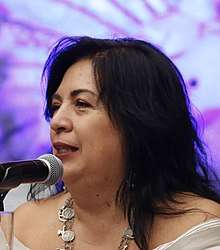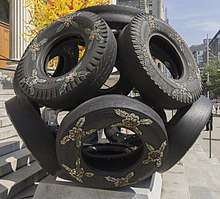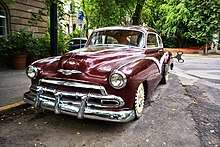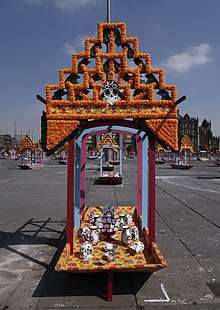Betsabeé Romero
Betsabeé Romero (born 1963) is a Mexican visual artist. Her works include sculptures, installations, printmaking, perforated paper, photographs, and videos.[1] She has exhibited widely, and has been featured in more than forty one-person exhibitions in the Americas, Africa, Asia and Europe.[2][3]
Betsabeé Romero | |
|---|---|
 Betsabeé Romero, 2016 | |
| Born | 1963 (age 56–57) Mexico City, Mexico |
| Nationality | Mexican |
| Alma mater | Universidad Iberoamericana |
| Known for | Visual artist, sculptor |
| Website | betsabeeromero |
Romero has described herself as a "mechanic artist".[1] She uses everyday materials such as used tires, other car parts, and chewing gum, significant in colonial history and representative of global urban consumption.[4][2] She combines these with traditional Mexican symbols, images and themes to reflect on history, culture, and the contradictions of modernity.[4][5]
Her work reflects on issues of social importance such as human migration,[3][5][6] gender roles,[7] cultural traditions,[3] religiosity[7] and miscegenation.[8] She grounds her work in the traditions and history of Mexico, but interpretations of her work connect it to contemporary and global contexts.[3]
Early life and education
Betsabeé Romero was born in Mexico City in 1963. She earned her Bachelor of Arts (Licenciatura en Comunicación) at the Universidad Iberoamericana (1980–1984).[9] She earned a Master of Fine Arts degree from Academia de San Carlos[3] in 1986.[1] She also studied at the Louvre and the École nationale supérieure des Beaux-Arts in Paris.[3][5] After studying in France, she returned to Mexico to study pre-Hispanic and colonial art,[5] earning a second master's degree in Art History from Universidad Nacional Autónoma de México (UNAM) in 1994.[1][3]
Culture exists where people write, sing, cook or dance. Our culture has been existing and developing on both sides of the border for a long time. Culture is not about borders or walls. Culture can cross a border and continue to live even within a song or within the aroma of a dish.[5]
Works
Materials


She intentionally chooses materials that have been used and discarded.[5] Some of her favorite materials are worn-down automobile tires and other car parts.[5] Through sculpture and painting,[5] she transforms these everyday materials to create "refashioned cars, carved tires, painted hoods, and incised mirrors."[1] They are overlaid with images and symbols inspired by Mexican history and culture, ranging from pre-colonial to present times.[1][2] Tires and cars also serve as symbols of mobility and human migration.[5][10][11][12]
Many of Romero's works combine aspects of sculpture and printmaking, as she pairs modern materials with traditional imagery. She carves textures, patterns, and symbols onto the surface of large discarded tires, treating the rubber as if it were wood. Sometimes she uses the sculpted wheels as giant printmaking rollers to create elaborate textile patterns or tracks in clay.[2][13][7]
The materials themselves have significance in a global context, evoking a history of colonialist exploitation[5] as well as recycling and renewal.[14] Natural rubber comes from the milky sap of Hevea brasiliensis, a tree that is indigenous to Brazil[15] and cultivated throughout South America and South-east Asia.[5][15] In spite of the creation of synthetic rubber, natural rubber still provides about 30 per cent of worldwide rubber production. The history of rubber is complex and difficult, with worldwide social, economic, and political impact.[15] Romero has also used chewing gum as a material, in works such as her suspended tire sculpture, De Tuti fruti.[1][2] Gum comes from chicle resin, which is extracted from the sapodilla tree of southern Mexico and Central America. Its history dates back to the Mayans and Aztecs.[16]
Through clever inversions of meaning and material, Romero's works question the way in which modern industry appropriates and transforms natural elements such as clay, rubber, and gum for mass production.[1]
Exhibitions
Betsabeé Romero has participated in more than 20 biennials, including those of Cuba,[9] Brazil,[9] Monterrey,[17] Cairo,[1] and Vancouver, Canada.[18] She has held more than 40 individual exhibitions in Mexico and other countries worldwide.[4] Some of her earliest solo exhibitions were at the Museo de Arte Carrillo Gil (El MACG) in Mexico City (1999), and Sous la grisaille de México, at Espace d'Art Yvonamor Palix in Paris, France (1999).[19]
A ten-year retrospective including 103 pieces of her work, Betsabeé Romero: Lagrimas Negras (Black Tears) was curated by Julián Zugazagoitia and shown at the Museo Amparo in Puebla, Mexico (2007–2008).[20] Versions of this exhibition have also appeared at Antiguo Colegio de San Ildefonso (2010),[21][22] and the Neuberger Museum of Art (2011).[1][2][23]
El Vuelo y Su Semilla (The Flight and Its Seed) examined interplaying themes of migration, colonization, food and traditional culture.[24] It was shown by the Mexican Cultural Institute in Washington, D.C. and San Antonio, Texas` (2017).[25] Each of five rooms featured a different type of work, some accompanied by Romero's poems.[24] Trenzando raíces (Braided roots) at the Art Gallery of York University, Toronto, Ontario (2018) was developed in collaboration with indigenous women from New Credit First Nation. They requested that one of the six pieces created remain at a ceremonial center in Mississauga.[26]
In 2018, Romero was featured as the fourth artist in the National Museum of Women in the Arts-organized New York Avenue Sculpture Project. Four sculptures of carved, painted tires were the first works to be specifically commissioned for the project. They address "themes of migration and movement".[10] Entitled as a group Signals of a Long Road Together, they will be shown for a two-year period on New York Avenue in downtown Washington, D.C.[10] Used car tires are carved, painted with metallic paint, and assembled into "totemic structures" that use interior lighting to increase visibility. Huellas y cicatricez (Traces and scars) is a 16-foot stack of four tires, carved with figures of running mothers and children, hand in hand. Movilidad y tensión (Mobility and tension) stacks eight-halves of tires, engraved with a blend of Islamic and European designs reminiscent of Mudéjar symbols from ancient Spain. In En cautiverio (In captivity) slender steel columns hold up two tractor tires, whose surfaces are painted with intertwining serpents. Movilidad en suspenso (Mobility in suspense) is an assembly of four tractor tires whose treads are decorated with traditional Mexican patterns.[3]
Romero has taken part in numerous collective exhibitions and her works are part of permanent collections worldwide, including the Daros Latinamerica Collection, Zurich, Switzerland;[27] the Jacques and Natasha Gelman Collection;[1] Los Angeles County Museum of Art (LACMA);[14][28] the Nelson-Atkins Museum of Art in Kansas City, Missouri,[29][30][31] and the Phoenix Art Museum.[12]
Day of the Dead installations
Betsabeé Romero has created a number of installations focused around the Day of the Dead.[32] The Day of the Dead is a holiday that takes place in Mexico and Central America on November 1 and 2 as a commemoration of the deceased. Its origins go back 3000 years, and reflect a fusion of pre-Hispanic culture and Catholic religion.[33]
In 2015 Romero created an installation for the Day of the Dead at the British Museum. In the Great Court, she created an altar dedicated to the Unknown Immigrant. She drew upon folk traditions of paper and metal art, creating cantolla hot air balloons shaped like skulls out of tissue paper and tin calacas skeletons to float above the Great Court.[34] Hanging paper banners printed on papel picado[34] were placed in the Round Reading room, and marigold serpents wound their way up the stairs.[32]

Betsabeé Romero's installation Canto de Agua (Song of water) was held in the Zócalo of Mexico City (2016), and opened by the mayor of Mexico City, Miguel Ángel Mancera.[35] The installation combined the cultural traditions of the Day of the Dead ofrenda or offering;[36] the trajinera, a traditional type of flat-bottomed boat;[37] and the social concerns of the present.[35] 103 trajineras were decorated as offerings to commemorate those who had died during the year and to connect their deaths to social conditions and problems of Mexico City.[35] The trajineras were created by Mexican artisans from Ciudad Nezahualcóyotl[35] and reflect traditions of pre-Hispanic times in which trajineras circulated in Tenochtitlán.[37]
Los huesos tienen memoria (Bones have a memory) at the Museo Dolores Olmedo (2016–2017) was dedicated to the almost 28 thousand missing persons registered by the Mexican federal government. Romero incorporated modern elements inspired by the lamps Dolores Olmedo made of Bohemian glass for her home.[38] Romero used flaked wax and tin and sugar skulls to create lights, which she sees as representing the light of living traditions that illuminate society.[39] Fabric banners were reminiscent of pre-Hispanic codices like the Codex Borgia. Arrays of sugar skulls recall Mesoamerican skull racks or Tzompantli where the skulls of sacrifices were exhibited.[38][39]
Awards and honors
Betsabeé Romero has been the recipient of numerous awards and honors, including the following:
- 1988, Oric'Art, Neuilly sur Seine, France[31]
- 1994, Jóvenes Creadores de Conaculta (scholarship for young creators), CONACULTA[40]
- 1994, Grand Prize, Acquisition Award in the II FEMSA Biennial, Mexico, for Refugio para un lecho de rosas (Shelter for a bed of roses) [41]
- 2006, first prize, Cairo Biennial, for Cuerpos vestidos (Dressed Bodies)[1]
References
- "Ten-Year Survey of the Work of Betsabeé Romero on View at the Neuberger Museum of Art". Art Daily. May 2, 2011. Retrieved October 21, 2018.
- Schwendener, Martha (June 3, 2011). "Leaving her mark with the well-worn". The New York Times. Retrieved October 21, 2018.
- "Artist Betsabeé Romero Creates First Commissioned Works for New York Avenue Sculpture Project" (PDF). National Museum of Women in the Arts. June 20, 2018. Retrieved October 21, 2018.
- "Betsabeé Romero: Tu Huella Es El Camino". Stanley and Gerald Rubin Center for the Visual Arts. September 20, 2018. Retrieved October 21, 2018.
- Mencia, Cecilia (August 28, 2018). "Memory and Migration: An Interview with Sculptor, Betsabeé Romero". DCTrending. Archived from the original on October 29, 2018. Retrieved October 21, 2018.
- Guenther, Rocío (June 11, 2017). "Migrants and Their Stories Take Center Stage at Instituto Cultural de México". Rivard Report. Retrieved October 21, 2018.
- Tafoya, Aylin (April 23, 2018). "Betsabeé Romero prepares for 'Tu huella es el camino' mixed-media exhibit". The Prospector. University of Texas at El Paso. Retrieved October 21, 2018.
- "Betsabeé Romero Named Official Artist For The 17th Annual Latin Grammy Awards". BOOM. October 11, 2016. Retrieved October 21, 2018.
- Borbolla, Gerardo (March 7, 2013). "Betsabeé Romero: "El arte es una forma de conocimiento"". El Universal. Retrieved October 18, 2018.
- "Artist Betsabeé Romero Creates First Commissioned Works for New York Avenue Sculpture Project". National Museum of Women in the Arts. June 20, 2018. Retrieved October 26, 2018.
- Marquez, Lysandra (April 13, 2017). "New artistic collaboration reflects history of migration". Downtown Devil. Retrieved October 28, 2018.
- "Betsabeé Romero Columna interminable (Endless Column) 2015". Phoenix Art Museum. Retrieved October 28, 2018.
- Lewis, Richard L.; Lewis, Susan Ingalls (January 1, 2018). The power of art. Cengage Learning. pp. 110–111. ISBN 9781337555555. Retrieved October 21, 2018.
- "The Artist as a Social Conscience A Resource Guide for Visiting" (PDF). LACMA. Retrieved October 21, 2018.
- Couper, Heather; Henbest, Nigel (May 30, 2007). "Green gold: How a Brazilian forest of rubber trees is bouncing back". The Independent. Retrieved October 27, 2018.
- Fiegl, Amanda (June 16, 2009). "A Brief History of Chewing Gum The Mayans and Aztecs were the first to unlock the positive properties of gum". Smithsonian Magazine. Retrieved October 28, 2018.
- "Ganadores Bienal de Monterrey. Colección FEMSA Del 28 de febrero, 2003". Museo Amparo. Retrieved October 28, 2018.
- Romero, Betsabeé (2014). "Every boundary is made by living beings Betsabeé Romero, Mexico". Vancouver Biennale. Retrieved October 27, 2018.
- "featured artists Betsabé Romero". LatinArt.com. Retrieved October 26, 2018.
- "Betsabeé Romero. Lágrimas negras Del 17 de octubre, 2007 al 12 de enero, 2008". Museo Amparo. Retrieved October 26, 2018.
- "Betsabeé Romero Lágrimas negras". Antiguo Colegio de San Ildefonso. Retrieved October 26, 2018.
- Bueno Delgado, P. (2014). Towards a Professional Learning Dialogue in Mexican Contemporary Art Museums. (Unpublished Doctoral thesis, City, University of London) (PDF). p. 246. Retrieved October 26, 2018.
- "Neuberger Museum of Art Opens Betsabeé Romero Exhibition Black Tears". Museum Publicity. May 1, 2011. Retrieved October 26, 2018.
- Irene, Laura (April 28, 2017). "At the Mexican Cultural Institute, Artist Betsabeé Romero Reflects on Identity and Culture of Mexican Immigrants". Retrieved October 28, 2018.
- Rindfuss, Bryan (June 13, 2017). "Mexican Cultural Institute Kicks Off 'A World of Migrants' Program with Betsabeé Romero's Exhibition 'El Vuelo y Su Semilla'". San Antonio Current. Retrieved October 26, 2018.
- "Mexican artist presents art exhibition in Toronto". El Universal. September 27, 2018. Retrieved October 26, 2018.
- "Daros Latinamerica Collection". E-Flux. June 17, 2016. Retrieved October 28, 2018.
- "Border Memory (Recuerdo de la frontera) Betsabeé Romero". LACMA Collections. Retrieved October 23, 2018.
- "Frida Kahlo and Diego Rivera Featured in Nelson-Atkins Exhibition". Nelson-Atkins Museum of Art. April 9, 2013. Retrieved October 23, 2018.
- "Sugar Skin (Piel de Azúcar), Betsabeé Romero". Nelson-Atkins Museum of Art Collection. Retrieved October 23, 2018.
- "Betsabeé Romero y su visión en el MACT". Milenio Digital Tampico. December 7, 2015. Retrieved October 23, 2018.
- "Days of the Dead festival at the British Museum". Mexican Embassy. November 2, 2015. Retrieved October 26, 2018.
- Lomelí, Francisco A.; Segura, Denise A.; Benjamin-Labarthe, Elyette (August 6, 2018). Routledge handbook of chicana/o studies. Routledge. p. 282. ISBN 9781138847873. Retrieved October 21, 2018.
- "The British Museum will celebrate the Mexican tradition of the Day of the Dead". México Distrito Federal. October 18, 2015. Retrieved October 28, 2018.
- Páramo, Arturo (October 29, 2016). "Inauguran ofrenda monumental 'Canto al Agua' en el Zócalo". Excelsior. Retrieved October 28, 2018.
- Herz, May (October 10, 2017). "The Day of the Dead Ofrenda: A Work of Love and Tradition A Heartfelt Work of Art". Inside Mexico. Retrieved October 29, 2018.
- "An Aquatic Paradise in Mexico, Pushed to the Edge of Extinction". The New York Times. February 22, 2017. Retrieved October 28, 2018.
- Gallo, Irma (October 19, 2016). "Betsabeé Romero asegura que "Los huesos tienen memoria"". Noticias 22 Digital. Retrieved October 28, 2018.
- "Los huesos tienen memoria Ofrenda inédita de Betsabeé Romero". Museo Dolores Olmedo. Retrieved October 28, 2018.
- "Betsabeé Romero, arte contemporáneo con tradición mexicana". Almomento. May 20, 2015. Retrieved October 23, 2018.
- "Why the Bienal Monterrey came to Mexico City". Phaidon. Retrieved October 23, 2018.